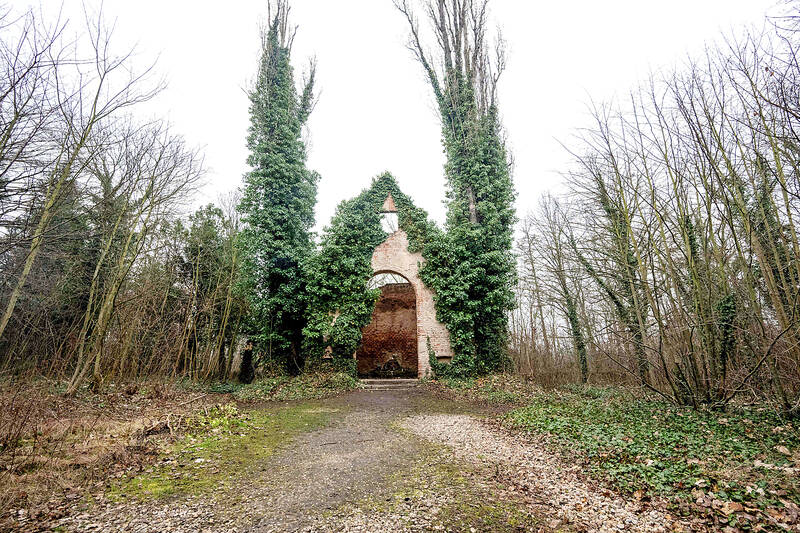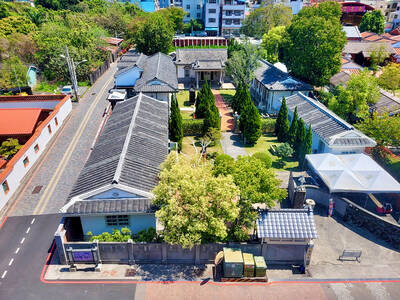It was the setting of the chilling graveyard scene in Amadeus, may have held the bones of Gavrilo Princip — the man who started World War I — and Margaret Thatcher paid a mysterious visit there when she was British prime minister.
An overgrown “lunatic graveyard” on the outskirts of Prague has become the Czech capital’s strangest attraction, drawing ghost hunters, scandal seekers, Satanists and other visitors lured by the supposedly strange energy of “Europe’s scariest cemetery.”
Around 4,200 people were laid to rest in the graveyard of the immense Bohnice psychiatric hospital, many without headstones.

Photo: AFP
“It’s a different kind of cemetery,” said Jiri Vitek, a former firefighter and deputy mayor of the local area who had become its de facto caretaker.
“The graveyard served standard psychiatric patients — schizophrenics, alcoholics, addicts, but also people you would not want to meet — arsonists, pedophiles, murderers,” he said.
Vitek said Gavrilo Princip, the Bosnian-Serb student who shot Archduke Franz Ferdinand and his wife in Sarajevo in 1914, triggering the Great War, may have been interred there before a shrine was created for him in his homeland.
Princip was the only prisoner in the Theresienstadt fortress north of Prague. A secret funeral took place in the cemetery supervised by prison guards three days after his death.
Vitek said the remote graveyard was the perfect place for Princip.
“Where else would Austria bury its worst criminal?”
MOZART BURIAL
The first person to be buried in Bohnice was an 11-year-old boy who died of tuberculosis in September 1909.
At that time, the hospital was the largest of its kind in the sprawling Austro-Hungarian empire — a veritable village with a church, laundry and a bakery.
“The patients worked in the fields, grew vegetables and worked in workshops,” said hospital spokeswoman Alzbeta Remrova.
When World War I hit, the burials included Austrian soldiers hospitalized with mental illnesses and psychiatric patients from Italy, evacuated to Prague.
Most died during a typhoid epidemic between 1916 and 1918, said Vitek.
The graveyard closed in 1951 and was left to looters and neglect for six decades, with its chapel bowing to time and ivy.
But its haunting atmosphere drew director Milos Forman there to film the heartbreaking burial scene in his Oscar-winning 1984 movie Amadeus, with the great composer Mozart thrown into a pauper’s grave, his body covered in quicklime.
THATCHER’S PILOT
Vitek said that British Prime Minister Margaret Thatcher paid a mysterious visit to the graveyard in 1990 to reportedly bring home the remains of a British pilot shot down at the end of World War II.
Nobody knew where the grave was, Vitek said, until a local vagrant identified it in exchange for a crate of rum. Over the years the graveyard has become a focus of dark fantasy — a place where local youths tried to scare each other and test their courage — especially its southwestern corner, which was reserved for criminals.
Some say it feels colder there than in the rest of the graveyard, blaming all that negative energy. But Vitek laughs this off.
“Non-believers were not buried in coffins, but in bags sanitized with lime. It’s the hardened lime that generates the cold,” he said.
In the 1980s, police busted a Satanic ritual in the cemetery.
More down-to-earth locals used it as a rubbish dump, and this is how Jiri Vitek found it in 2011 as he walked his dog. “It was full of old fridges, washing machines, sofas and debris. So I started to clean it up,” Vitek said.
He has gradually started to organize guided tours of the cemetery, has been working on a book and plans a revamp of the local chapel and memorial.
“As a firefighter I saved the living for 15 years. Now for the past 12 years, I’ve been saving the dead.”

April 28 to May 4 During the Japanese colonial era, a city’s “first” high school typically served Japanese students, while Taiwanese attended the “second” high school. Only in Taichung was this reversed. That’s because when Taichung First High School opened its doors on May 1, 1915 to serve Taiwanese students who were previously barred from secondary education, it was the only high school in town. Former principal Hideo Azukisawa threatened to quit when the government in 1922 attempted to transfer the “first” designation to a new local high school for Japanese students, leading to this unusual situation. Prior to the Taichung First

Chinese Nationalist Party (KMT) Chairman Eric Chu (朱立倫) hatched a bold plan to charge forward and seize the initiative when he held a protest in front of the Taipei City Prosecutors’ Office. Though risky, because illegal, its success would help tackle at least six problems facing both himself and the KMT. What he did not see coming was Taipei Mayor Chiang Wan-an (將萬安) tripping him up out of the gate. In spite of Chu being the most consequential and successful KMT chairman since the early 2010s — arguably saving the party from financial ruin and restoring its electoral viability —

The Ministry of Education last month proposed a nationwide ban on mobile devices in schools, aiming to curb concerns over student phone addiction. Under the revised regulation, which will take effect in August, teachers and schools will be required to collect mobile devices — including phones, laptops and wearables devices — for safekeeping during school hours, unless they are being used for educational purposes. For Chang Fong-ching (張鳳琴), the ban will have a positive impact. “It’s a good move,” says the professor in the department of

Toward the outside edge of Taichung City, in Wufeng District (霧峰去), sits a sprawling collection of single-story buildings with tiled roofs belonging to the Wufeng Lin (霧峰林家) family, who rose to prominence through success in military, commercial, and artistic endeavors in the 19th century. Most of these buildings have brick walls and tiled roofs in the traditional reddish-brown color, but in the middle is one incongruous property with bright white walls and a black tiled roof: Yipu Garden (頤圃). Purists may scoff at the Japanese-style exterior and its radical departure from the Fujianese architectural style of the surrounding buildings. However, the property